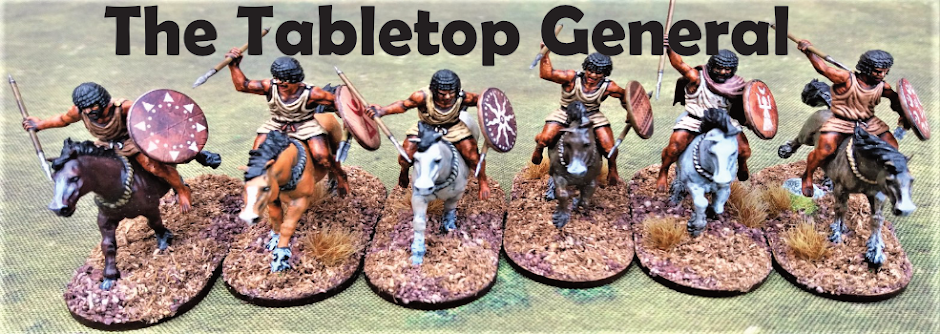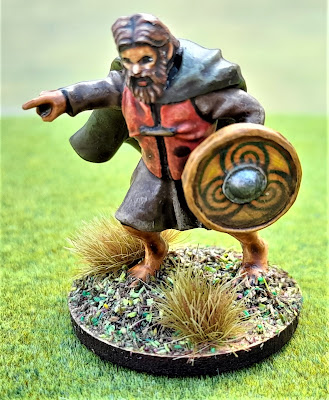No colourful
pictures of wargames figures today… just some musings on a four year journey
searching for the perfect set of Ancient or Medieval skirmish wargame rules!
Back in March 2017, I started
searching for a set of small scale Ancient/Medieval skirmish rules and drew a
complete blank. Lion Rampant, published by Osprey, was probably the closest I
got to finding what I was looking for, but it didn't quite fit right with the
earlier period games I wanted to play. At the time, the only options appeared
to be modifying rule sets for other periods or committing the ultimate
blasphemy and adapting fantasy rules to fight small scale historical actions! A
year later, I had given up the search and began to work towards expanding my
Victrix Carthaginian forces into a big scale army for Swordpoint rules.
Then suddenly, over the past
two years, my book shelf has begun to groan under the weight of a rash of
skirmish rule sets designed specifically with us "Ancient" gamers in
mind. First to arrive there, in April 2019 was the Too Fat Lardies classic, Dux
Britanniarum. These remain my favourite rule set of all time! I've painted a
Romano-British warband for Dux and, at the time of typing this missive, I just
have another three skirmish cavalry to paint to complete my Irish Raider
Warband. Dux is very period specific and there is little opportunity to mess
about with the composition of the warbands, but it does whisk you away, back in
time to the uncertainty and barbarity of post Roman Britain.
August 2019 saw the arrival of
S.P.Q.R. from Warlord Games through my letterbox. For a short time, I was in
skirmish heaven, and began to plan the multitude of warbands I was going to
build but, S.P.Q.R. suffered from the same drawback that had lead to my
abandoning Bolt Action in favour of Chain of Command; the game was all about
building the perfect warband and giving your characters endless superpowers
that you could upstage your opponent with.
Then, about a year ago, along
with Covid-19, came, what will probably become, the ultimate small force
ancient skirmishing game of all time; Clash of Spears! Clash of Spears lead to
some hurried re-cycling of those Victrix Carthaginians I had started to base
for Swordpoint and I now have two Clash warbands, having completed a Celtic
force as well. With things being as they have been over the last twelve months,
my Clash warbands have spent most of their lives in the boxes I bought to
transport them in, victims, like the rest of us, of lockdowns and travel
restrictions.
Summer 2020 saw the arrival of yet
another “must have” rule set; Infamy! Infamy! by those Too Fat Lardies again.
For a time, Infamy! completely took over my life as it gave me the opportunity
to build a warband of filthy, dirty Ancient Germans; the barbarians of all
barbarians. Those nasty Germans played a significant role in two of my favourite
historical events; the destruction of Publius Quinctilius Varus’ legions in the
Teutoburg Forest and the Batavian Revolt of 69/70AD. When you combine the
arrival of Infamy! with Victrix putting out a set of Germanic Warriors (a bit
too pretty to be honest) it was like every portent and omen of good fortune had
aligned with discovering next week’s Lottery numbers spelled out in a tin of
Alphabetti Spaghetti! My beloved German warband has, like my Clash warbands,
remained locked down in their storage box; another victim of these trying times
in which we live.
By Christmas
2020, with things looking even more dire than they had in April, I had started
to think that I probably needed to look for a game system that was quick, simple
and small scale enough to build two warbands and be able to play solo at the
dining room table! Through the letter box came Mortal Gods… fulfilling all of
the above and all about another subject that I could get excited about, especially
when there was the option to include figures from Greek mythology! Well, those
excellent plastic skeleton warrior figures from Wargames Atlantic that I’d been
drooling over for weeks would fit in perfectly with scenarios based around the
story of Jason and the Argonauts!
And so, we
come right up to date, with the final addition to the stack of skirmish games
lined up chronologically on the book shelf, since that plea back in 2017, for
someone to publish anything that an “ancient” skirmish wargames fan could spend
his pension on. The Barons’ War by Andy Hobday, complete with a whole range of
associated figures by Footsore Miniatures! Yet again, this a subject that I
have a real interest in; what’s not to like? Knights, heraldry, chivalry, bows,
crossbows, long pointy sticks and all the treachery and mayhem associated with
a civil war! So far, I’m still at the reading through the rules stage and I’m
only slowly getting the urge to splash some cash and start building a retinue
or two. Having said that, I have identified two likely knights from my localish
area, who could engage in some raiding and pillaging and I have dug out some
long forgotten Fireforge plastic figures that could comfortably make up the
bulk of some perfectly acceptable retinue men to do the dastardly bidding of
said knights. Two negatives so far are the system for building retinues which,
although much more flexible than Lion Rampant, has the potential to become a
bit of an arms race and lead to the quest of building of the perfect retinue. The
other gripe, is the format of the book; A5 and bound in a way that means it
just wont stay open at the page you need to refer to in the middle of game! If
I had a ring-binding machine, I’d take it apart and put it back together with a
nice plastic binding.
So, four years
on from that forlorn search for a set of small-scale ancient period skirmish
rules, there are now so many that I’m like a penny in a barrel, rattling around
trying to settle on which one I should spend my time and money on. With my
second Dux Britanniarum warband so near completion I really have to get my head
down and get the last few figures painted and then get them all based up ready
for action. After that… The Barons’ War is beginning to rise to the top of the charts and seems to be the one that has the flexibility to make it most achievable.
Let’s see what the rest of 2021 brings!



















